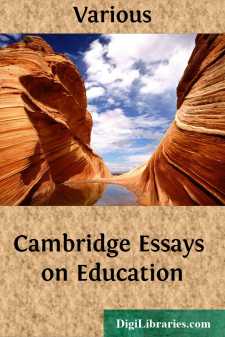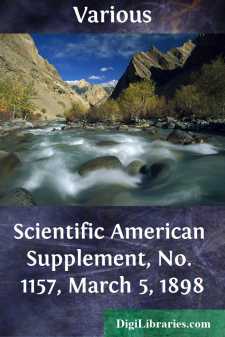Categories
- Antiques & Collectibles 13
- Architecture 36
- Art 48
- Bibles 22
- Biography & Autobiography 813
- Body, Mind & Spirit 142
- Business & Economics 28
- Children's Books 16
- Children's Fiction 13
- Computers 4
- Cooking 94
- Crafts & Hobbies 4
- Drama 346
- Education 46
- Family & Relationships 57
- Fiction 11829
- Games 19
- Gardening 17
- Health & Fitness 34
- History 1377
- House & Home 1
- Humor 147
- Juvenile Fiction 1873
- Juvenile Nonfiction 202
- Language Arts & Disciplines 88
- Law 16
- Literary Collections 686
- Literary Criticism 179
- Mathematics 13
- Medical 41
- Music 40
- Nature 179
- Non-Classifiable 1768
- Performing Arts 7
- Periodicals 1453
- Philosophy 64
- Photography 2
- Poetry 896
- Political Science 203
- Psychology 42
- Reference 154
- Religion 513
- Science 126
- Self-Help 84
- Social Science 81
- Sports & Recreation 34
- Study Aids 3
- Technology & Engineering 59
- Transportation 23
- Travel 463
- True Crime 29
The Atlantic Monthly, Volume 15, No. 88, February, 1865
by: Various
Categories:
Description:
Excerpt
OUR FIRST GREAT PAINTER, AND HIS WORKS.
On the 8th of July, 1843, Washington Allston died. Twenty-one years have since gone by; and already his name has a fine flavor of the past added to its own proper aroma.
In twenty-one years Art has made large advances, but not in the direction of imagination. In that rare and precious quality the works of Allston remain preëminent as before.
It is now so long ago as 1827 that the first exhibition of pictures at the Boston Athenæum took place; and then and there did Allston first become known to his American public. Returned from Europe after a long absence, he had for some years been living a retired, even a recluse life, was personally known to a few friends, and by name only to the public. The exhibition of some of his pictures on this occasion made known his genius to his fellow-citizens; and who, having once felt the strange charm of that genius, but recalls with joyful interest the happy hour when he was first brought under its influence? I well remember, even at this distance in time, the mystic, charmed presence that hung about the "Jeremiah dictating his Prophecy to Baruch the Scribe," "Beatrice," "The Flight of Florimel," "The Triumphal Song of Miriam on the Destruction of Pharaoh and his Host in the Red Sea," and "The Valentine." I was then young, and had yet to learn that the quality that so attracted me in these pictures is, indeed, the rarest virtue in any work of Art,—that, although pictures without imagination are without savor, yet that the larger number of those that are painted are destitute of that grace,—and that, when, in later years, I should visit the principal galleries of Europe, and see the masterpieces of each master, I still should return to the memory of Allston's works as to something most precious and unique in Art. I have also, since that time, come to believe, that, while every sensitive beholder must feel the charm of Allston's style, its intellectual ripeness can be fully appreciated only by the aid of a foreign culture.
Passing through Europe with this impression of Allston's genius, in the Venetians I first recognized his kindred; in Venice I found the school in which he had studied, and in which Nature had fitted him to study: for his eye for color was like his management of it,—Venetian. His treatment of heads has a round, ripe, sweet fulness which reminds one of the heads in the "Paradiso" of Tintoretto,—that work which deserves a place in the foremost rank of the world's masterpieces. The great praise implied in this comparison is justly due to Allston. The texture and handling of his work are inimitable. Without any appearance of labor, all crudeness is absorbed; the outlines of objects are not so much softened as emptied of their color and substance, so that the light appears to pass them. The finishing is so judicious that the spectator believes he could see more on approaching nearer. The eye searches the shade, and sees and defines the objects at first concealed by it. The eye is not satiated, but by the most artful means excited to greater appetite. The coloring is not so much harmonious as harmony itself, out of which melodies of color play through the picture in a way that is found in no other master but Paul Veronese. As Allston himself expressed it, he liked to echo his colors; and as an echo is best heard where all else is silence, so the pure repose of these compositions gives extraordinary value to such delicate repetitions of color. The effect is, one might say, more musical than pictorial. This peculiar and musical effect is most noticeable in the landscapes. They are like odes, anthems, and symphonies. They run up the scale, beginning with the low-toned "Moonlight," through the great twilight piece called "After Sunset," the "Forest Scene," where it seems always afternoon, the gray "Mountain Landscape," a world composed of stern materials, the cool "Sunrise on the Mediterranean," up to the broad, pure, Elysian daylight of the "Italian Landscape," with atmosphere full of music, color, and perfume, cooled and shaded by the breezy pines, open far away to the sea, and the sky peopled with opalescent clouds, trooping wide on their celestial errands.
Of this last landscape the poetic merit is as great as the artistic excellence is unrivalled. Whoever has made pictures and handled colors knows well that a subject pitched on a high key of light is vastly more difficult to manage than one of which the highest light is not above the middle tint. To keep on that high key which belongs to broad daylight, and yet preserve harmony, repose, and atmosphere, is in the highest degree difficult; but here it is successfully done, and again reminds us of the Paul Veronese treatment. Though a quiet picture, it is full of brilliancy. It represents a broad and partly shaded expanse, full, also, of light and sweet sunshine, through which the eye travels till it rests on the distant mountain, rising majestically in grand volcanic forms from the horizon plains. The sky is filled with cloudy veils, floating, prismatic; some quiet water, crossed by a bridge which rests on round arches, is in the middle distance; and a few trees near the foreground form the group from which rises the stone-pine, which is the principal feature in the picture, and gives it its character....












